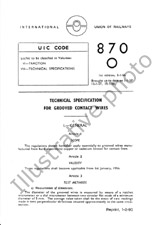We need your consent to use the individual data so that you can see information about your interests, among other things. Click "OK" to give your consent.

UIC A186/RP12-1ed.
Pantograph/Overhead line Interaction - Contact Strip/Wire Interaction Materials (CoStrlM) - Results of bench tests and conclusions
Translate name
STANDARD published on 1.3.2013
The information about the standard:
Designation standards: UIC A186/RP12-1ed.
Publication date standards: 1.3.2013
SKU: NS-1189775
The number of pages: 110
Approximate weight : 361 g (0.80 lbs)
Country: International technical standard
Category: Technical standards UIC
Annotation of standard text UIC A186/RP12-1ed. :
The railways use different voltages and frequencies (AC 25 kV 50 Hz, AC 15 kV 16,7Hz, DC 3 kV and DC 1,5 kV) to operate electric railway vehicles; therefore it is necessary to use different materials for the contact strips and catenary contact wires. In addition many countries do not allow the use of certain combinations of materials for those two elements due to the lack of experience as to their wear behaviour. The aim of this project is to identify the best combinations of materials for contact strips and wires on different networks, and describe the interaction between contact strip and wire in terms of wear and deterioration over time. Once this objective has been met it will be possible to enhance the content of UIC Leaflets 608 and 794-1 and amend the EN 50367 and EN 50405 standards. The present report contains the results from tests performed on two different benches (Hoffmann et Polimi) and a comparison of these results with the data collected via the questionnaire (UIC Report A 186/RP 11). "+ "
Name:Wechselwirkung Stromabnehmer/Fahrleitung - Schleifleiste/Fahrdraht - Zusammenwirken des Materials (CoStrim) - Ergebnisse der Prüfstandsversuche und Zusammenfassung des Projekts| Die Bahnen verwenden unterschiedliche Spannungen und Frequenzen (AC 25 kV 50 Hz, AC 15 kV 16,7 Hz, DC 3 kV und DC 1,5 kV) für den Betrieb elektrischer Eisenbahnfahrzeuge, was den Einsatz verschiedener Materialien für Schleifleisten und die Fahrdrähte der Oberleitungen erforderlich macht. Außerdem werden in einigen Ländern bestimmte Materialkombinationen für diese beiden Komponenten nicht akzeptiert, da man über keine Erfahrungen hinsichtlich ihres Verschleißverhaltens verfügt. Ziel dieses Projektes ist es, die für die verschiedenen Bahnen geeigneten besten Materialkombinationen für Schleifleisten und Fahrdrähte zu finden und die Wechselwirkung zwischen Fahrdraht und Schleifleiste in Bezug auf Verschleiß und Beschädigungen zu erstellen. Nach Abschluss der Arbeiten wird eine Ergänzung der UIC-Merkblätter Nr. 608 und 794-1 sowie die Anpassung der Euronormen EN 50367 und EN 50405 möglich sein. Der vorliegende Bericht beinhaltet die Ergebnisse der verschiedenen Prüfstandsversuche (Hoffmann und Polimi) sowie deren Abgleich mit den aus dem Fragebogen hervorgegangenen Daten (UIC A 186/RP 11). "+ "
We recommend:
Updating of laws
Do you want to be sure about the validity of used regulations?
We offer you a solution so that you could use valid and updated legislative regulations.
Would you like to get more information? Look at this page.



 Cookies
Cookies
